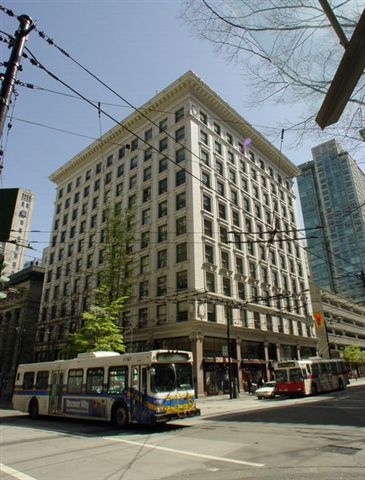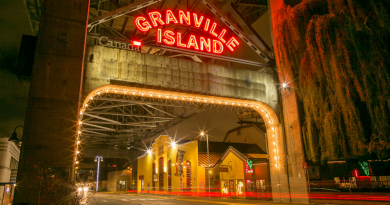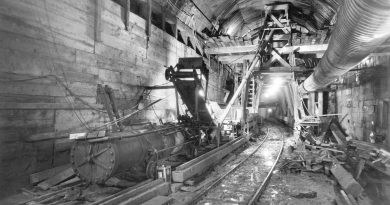The Rogers Building
Picture the corner of Pender and Granville in 1913, when Vancouver cars and streetcars were still on the “wrong” side of the street.
You also have a good view of the Rogers Building which has been standing at the north-east corner of Pender and Granville for more than 90 years. (Construction began in 1911, the building opened in 1912.) It gets its name from Jonathan Rogers, who can be counted among Vancouver’s earliest pioneers. In 1949 Peter Carter-Page wrote in The Province that Rogers’ story is largely Vancouver’s.
Rogers, Carter-Page told us, was born in Plas Onn, Denbighshire, Wales, and until he was 15 spoke not one word of English. He arrived in Vancouver, a fresh-faced youth of 22, in May of 1887—aboard that famed first CPR train from Montreal. Rogers was the first passenger to step off the train, and he recalled that the Vancouver City Band struck up the tune See the Conquering Hero Comes. Rogers later confessed, with some embarrassment, that he thought the band was playing it for him, as the first person to emerge from the train.
The city was a simpler place then: Rogers could recall when horse races were run down Granville Street.
He liked the place so much he stayed for the rest of his life, nearly 60 years more. Twenty-six of those years were spent on the city’s park board, nine of them as chairman. He also served twice as an alderman, and twice as president of the board of trade (1914 and 1915).
But he began simply, as a painter, helping to paint the first Hotel Vancouver. He later became a builder and contractor, and it’s said that more than 300 metres (1,000 feet) of Granville Street footage was built by him. The building for which he will be best remembered—and not just because it’s named for him—is the Rogers Building.
Seattle architects

[Photo: Joe Goldberg, Flickr]
This 10-storey beauty was designed by a Seattle firm, Gould and Champney. The October 20, 1911 issue of B.C. Saturday Sunset gave some of the details of “what promises to be one the finest office buildings on the Pacific Coast . . .” The building, said Sunset, “is designed along the lines of the modern French Renaissance (with an) exterior of polished Glasgow granite, in combination with cream-colored terra cotta facing . . . All the interior finish woodwork is to be of hardwood with white Italian marble corridors and stairs throughout . . . . The building will be a monument to Alderman Rogers, whose faith in the future of this city is exemplified in the erection of a building which, when completed, will represent an expenditure of nearly $600,000.”
Writing in The Greater Vancouver Book, Sean Rossiter says: “Carl F. Gould was a Seattle architect who had mastered that city’s terra cotta material—glazed tiles formed into classical details with weather-resistant qualities appropriate to this climate. When the worldwide collapse of lumber prices in 1910 ended Seattle’s boom, Gould and other architects travelled the short distance north to Vancouver where higher prices persisted because of B.C.’s access to British markets. Gould’s Rogers Building (1911-12) at 470 Granville is one sumptuous example of what architects from a more sophisticated city could do in booming Vancouver.”
Sold!
The Rogers Building was a hit. His years of study of office buildings were rewarded when, after the building had been operating for a while, builders in other cities began to write and ask for copies of the plans.
“I feel that I am parting with an old friend,” Rogers said in September of 1927 when he sold the building to General F. A. ‘One Arm’ Sutton. The old friend went for a sum “exceeding $1 million.” It was the largest real estate transaction in the city to that time.
William Mercer remembers the Rogers Building well. He worked in it for 25 years, starting in 1938, first as the building engineer, later as the manager. “Oh, I remember all that white marble,” Mercer told us. “It was even down in the basement. They had a huge barbershop down there, it must have been the most ornate in the city; it opened in 1913. Eighteen chairs, plate-glass mirrors on every wall, marble pillars. Do you remember McLeod’s Restaurant down there? Fifteen-foot ceilings!”
That barbershop was famous. “For more than half a century,” Tony Eberts wrote in 1973 in the Province, “it was a meeting place, an exchange for news, gossip and stock market tips, a basement oasis of relaxation and luxury—and a good spot to get a haircut.”
One of the patrons of the shop back then was the pioneer lawyer and politician Leon Ladner, who at the time Tony wrote had been getting his hair cut there for more than 50 years. But his longevity was exceeded by one of the barbers, Len Percival, who retired in 1962 after more than 60 years as a barber. More than a hundred of his businessmen customers gathered in the shop to wish Len well.
Mercer had another memory: “Mr. Rogers got the building back from One-Arm Sutton, you know. Oh, yes. One-Arm had pretty grandiose plans, but they didn’t work out. So the old man got the building back in, oh, about 1940-41.”
Elizabeth Rogers
Rogers’ wife, Elizabeth, took over the building when her husband died in 1945, aged 80. Elizabeth Rogers was a prominent Vancouverite in her own right. Like her husband, she was long-lived. She died in 1960 at age 83. (The meeting that resulted in the formation of the Vancouver Art Gallery was held in the Rogers’ living room.)
By the time the Koerner Foundation bought the Rogers Building in 1955, its price had increased to $1.25 million. The present owner, Equitable Real Estate Investment Corp., bought the building from the foundation in 1976.
Dunn’s Tailors, a firm established in 1936, occupies the ground floor of this handsome old building.


![Fountain Chapel Picnic, 1935 [Photo credit: Gibson Family]](https://vancouverhistory.ca/wp-content/uploads/2021/02/community-390x205.jpg)

